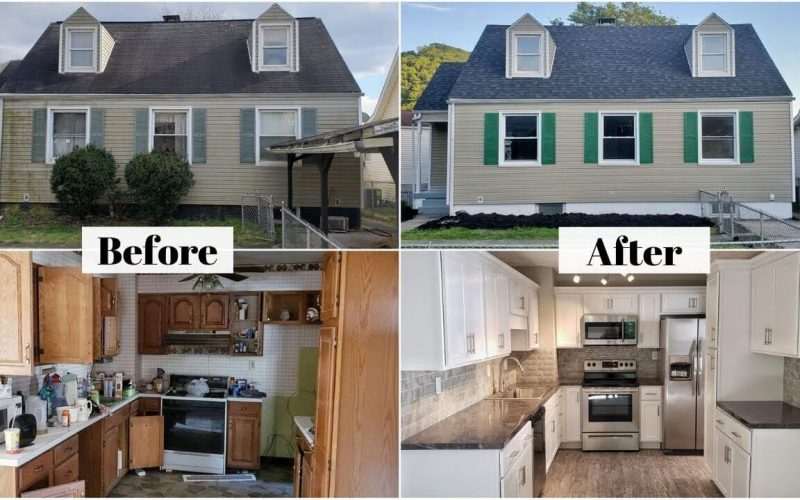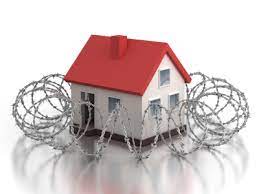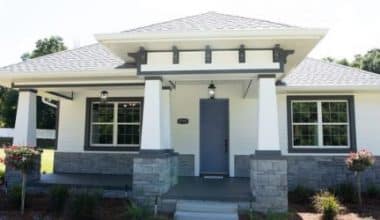To get started flipping houses, you must first learn about real estate. While popular TV shows make house flipping appear to be a straightforward process, they only portray a small portion of the process. A large part of the labor involved in flipping a house is dealing with variables. We have five steps to ensure you learn how to flip a house as a beginner before investing tens of thousands of dollars in your business and succeeding. But first, it’s critical to grasp what house repairs and flips entail.
What Is House Flipping?
House flipping is the practice of a real estate investor purchasing houses and then reselling them for a profit. A house must be purchased with the goal of immediately reselling it in order to be labeled a flip. The time between purchase and sale can range from a few months to a year.
House flipping is classified into two types:
- An investor purchases a property with the potential to increase in value with the necessary renovations and updates. They gain money after finishing the work by selling the house for a much higher price than they paid for it. You may have heard this referred to as a “fix and flip.”
- An investor purchases a home in a market where home values are fast rising. They make no improvements, and after a few months of keeping the property, they sell it at a higher price and profit.
We’re mostly focusing on the first definition of fix-and-flip and giving you with advice to help you choose a house, perform modifications, and sell smartly.
How to Flip a House in 5 Easy Steps For Beginners
Before you begin flipping houses, you must first understand the fundamental steps. This increases your chances of success while decreasing your financial risk. Here are 5 steps you may take to begin house flipping:
- Use cash to fund the house flip.
- Understand the Market
- Create a House Flip Budget
- Make Smart Renovations
- Seek the advice of a Local Real Estate Expert
#1. Use cash to fund the house flip.
Flipping houses may be a risky business, especially if you don’t have any money. It’s easy to understand how adding debt to the mix simply makes matters worse. Here’s why we always propose flipping a house for cash:
- There are no interest charges: House flippers who borrow money may end up paying interest for months, increasing the amount they must sell the house for just to break even.
- There is no rush to sell: When you use debt to finance a flip, you may act in desperation. If you can’t sell the house, you’ll most likely drop the price and lose money. Cash-only house flippers may ride out a weak market because they don’t have interest payments piling up against them each day the property remains unsold.
- There will be no debt to hold you back: Most importantly, any type of “investment” using debt is a bad idea. Period. Even with cash, trying to sell a flipped house for more money than you invested in it is a gamble. Using debt in the process increases your chances of losing money if your plans go through.
Read Also: Best Time To Buy a House In 2022
Let’s look at an example to demonstrate why borrowing money to flip a house isn’t a good idea: You take out a loan to buy a house to flip, and everything appears to be going swimmingly until renovations take six months instead of four. When you advertise your home, it sits on the market for a month until you’re forced to lower the price and sell it for far less than you expected.
You close a month later and receive your payment. However, a significant portion of your reward is used to repay the loan plus eight months of interest! This is in addition to the standard selling charges such as agent commissions, taxes, and title fees.
Desperation would not have compelled you to sell low if you had flipped the house with cash. With no interest payments to worry about, you might have waited until the market warmed up and the price was perfect before selling.
The financial risk of house flipping is simply not worth it unless you can pay cash.
#2. Understanding the Market
Many house flippers are so focused on their next endeavor that they overlook the less attractive part of the profession. However, if you don’t grasp the market and real estate trends in your area, you may encounter the following problems:
You’re not sure if you’re getting a decent bargain on the house you’re buying. When the house is listed at market value, the sale price should be low enough that you can perform the modifications and yet come out ahead.
You are unable to precisely estimate the home’s prospective value. Your idea for the home must be compatible with the neighborhood’s reality and the ability of the neighborhood’s residents to afford the home you design.
You have no idea how to price the house. If you bought a house in a community with predominantly $130,000–150,000 properties, you should price your flip at the lower end of that range when the time comes to sell.
So, how can you have a thorough understanding of the market in order to execute a successful flip? Find a real estate agent in your neighborhood who has years of expertise. Your agent may assist you in narrowing down your property search to the right neighborhoods based on your price range, renovation budget, and anticipated profit.
Read also: Cap Rate in Real Estate: Investors Guide to Know Capitalization Rates
You may believe that the house you spotted online is a steal at $145,000 and has a lot of potentials. However, if the prettiest and largest house in the neighborhood had sold three months ago for $160,000, any renovations would most likely outprice the neighborhood. And you’d be stuck with a house that couldn’t be sold.
Working with a real estate agent that understands the market like the back of their hand pays off. When you’re ready to sell, your agent can use their expertise to price your house competitively so you earn top dollar. Working with a top-tier agent can assist you in making a wise investment that keeps your finances on track.
#3. Create a House Flip Budget
Make a budget as soon as you purchase an investment property. Before you sign the contract, determine your pricing range for acquiring a home, repairing repairs, finishing renovation projects, and paying closing expenses.
Make a list of any cosmetic projects as well as any costly overhauls, such as plumbing or electrical issues. If you don’t have any construction experience, a contractor can tell you what needs to be fixed and how much it will cost. Surprise repairs may make or break a flip, so do your research here.
Get a house inspection and any other particular examinations you may require once you’re under contract. It is always preferable to detect problems early on rather than being caught off guard later.
#4. Make Smart Renovations
Dreams of shining hardwood floors, trendy light fixtures, and great kitchens with professional-grade stoves may easily spiral out of control. That is why it is critical to plan your budget ahead of time and then ensure that your updates stay on track and truly increase the value of the home.
Don’t forget that major upgrades, such as kitchens and bathrooms, can make or break your flip. Take, for example, the kitchen. The average cost of a significant kitchen makeover, according to the 2020 Cost vs. Value report, is about $68,500. 2 The average amount recovered from that expense is only about $40,000. 3 When you’re flipping a house, you don’t want to see that kind of ROI.
If you want to sell your house for $220,000, don’t spend $60,000 on bespoke cabinetry, high-end finishes, and that dream kitchen island! Consider a more cost-effective renovation that focuses on repainting existing cabinets, installing granite counters, and updating appliances. You’ll pay less and have a much better chance of recouping your costs when you sell the house.
While you may make a few major modifications on a flip, don’t underestimate the significance of minor changes. A fresh coat of paint, new hardware, and new landscaping can all make a big difference!
#5. Seek the advice of a Local Real Estate Expert
Is it possible to profit from house flipping? You most certainly can if done correctly! Flipped homes sold for an all-time high median price of $267,000 in the second quarter of 2021, with a gross profit of about $67,000.
Remember that the gross profit does not include the cost of repairs and renovations. However, if you can flip with cash and keep within your renovation budget, it is entirely possible to make a good return on your investment.
The secret to effectively flipping a house is to do it with cash, make a wise investment in the sort of house you buy, choose repairs within your budget, and sell it promptly. Having a real estate professional on your team makes all of this possible!
A qualified real estate agent can provide the market expertise and practical counsel you need to make a wise investment, whether you’re buying a house to live in for years or to flip in six months.
Is House Flipping Profitable?
Flipping houses may appear to be straightforward, but it is not. Let’s face it: a house flip may either be a dream or a nightmare.
When done correctly, a house flip may be a terrific investment and quite profitable. You can perform sensible modifications in a short period of time and sell the house for considerably more than you paid for it.
However, if done incorrectly, a house flip can easily go in the opposite direction. We’ve all heard horror stories about house flipping, where what appeared to be a fantastic price turned out to be a house with a weak foundation and a leaking roof. In the end, a house flip may not make you money. It might cost you thousands of dollars.
You don’t want to lose money if you decide to flip a house. You want to make sensible investment and profit from it. That’s why many people hire an appraiser to determine the value and then apply the 70 percent guideline to determine whether a fix and flip will pay off as expected.
How Much Does a House Flip Cost?
The cost of flipping a house varies substantially from house to property. A lower-priced home in a desirable neighborhood may be a steal, but if it requires extensive repairs, your profit margin may be limited. On the other hand, a bargain in a rising neighborhood may not require much attention, but if the market isn’t as hot, you may be stuck with the home for longer than you want.
When looking for a house to flip, you must estimate and account for a variety of aspects. To decide whether a house is a smart investment, experienced house flippers utilize a 70 percent rule. Follow these four steps to compute the 70 percent rule:
- Determine the home’s after-repair value (ARV): Determine the value of the house after repairs and renovations.
- Calculate the cost of the required repairs: Is it necessary to replace the furnace in the house? Is your kitchen cabinetry old and damaged? When evaluating the home, be aware of everything that will need to be fixed or remodeled, and provide an exact cost estimate.
- Subtract the cost of repairs from 70% of the ARV: Assume the ARV of a house is $200,000. Divide it by 0.7 to get 70%, or $140,000. Subtract the cost of repairs from the $140,000 figure. In this example, we’ll estimate the total cost of repairs and renovations to be $30,000.
- Use the result to figure out how much you should pay for a house: If 70 percent of your ARV is $140,000 and the repairs cost $30,000, you should not pay more than $110,000 for the house.
How Long Does It Take To Flip A House?
When choosing whether flipping a house is the best option for you, it’s critical to understand how long it takes. The amount of profit you make will be affected by how soon your home flips. According to Attom, it takes about 6 months to flip a house, but understanding the elements that influence this can assist speed up the process.
Buying
The time it takes to buy a house varies, but if you find a marketable property, you should be able to do it fast. Some of the best homes for house flipping don’t last long on the market, so it’s important to keep watchful and have a flexible schedule. Once you’ve discovered the ideal property and made a winning offer, it usually takes around a month to buy a house.
Renovating
The cost of renovating a house varies based on the home. Some homes will require more work before they can be sold, while others will simply require a few modest changes. The amount of labor and what you want to perform will determine how long it takes to fix house repairs.
Renovations can take many months if you do them yourself, but hiring pros can substantially shorten the process.
Selling
The amount of time required to sell a house, like renovating, is determined by the amount of work done. When you sell your property on your own, it takes a long time – maybe a couple of months – because there is a lot of paperwork to compile. Hiring a real estate agent will reduce your workload and make it much more manageable.
Is House Flipping Possible without Money?
There are various ways to secure money to flip a house if you don’t have enough cash or want to reduce risk. Hard money, private, or real estate crowdfunding lenders can assist you to flip houses.
Is House Flipping Dangerous?
The largest danger is that you won’t be able to sell the home for a profit or that repairs and improvements will cost more than expected. Flipping houses involves fraud and scams. Not all houses are flippable.
Is House Flipping Hard?
Renovating and flipping houses takes time. Property hunting might take months. Fixing the house takes time. Demolition and construction might take up evenings and weekends if you work.
Flipping or Renting—Which Is Better?
Flipping and renting are best for short-term investors. If you require a steady income and have more time and money, you could acquire a rental property.
Can You Make Money Flipping Houses?
While working full-time, flipping property might provide supplementary cash. It lets you “dip your toe in the water” before quitting your full-time job to see if flipping houses is for you.
Conclusion
House flipping can be a viable business choice if you go in with the appropriate plan and have carefully analyzed the financial elements. However, you are unlikely to achieve quick success with this method, and you may make numerous errors and lose money along the road.
The appropriate team of professionals can greatly simplify this process. Work with a knowledgeable real estate agent who can provide you with market insights and assist you in understanding the types of homes buyers are looking for.
A skilled general contractor may also assist you in determining the existing state of a house. This will assist you in avoiding investing in a money hole. Of course, you’ll need to plan ahead of time for your finance requirements.
The correct financing and interest rate can make it easier to fix up and flip a house.
How To Flip a House FAQs
What is the 70% rule in house flipping?
The 70% rule assists home flippers in determining the highest price they should pay for an investment property. Essentially, they should not spend more than 70% of the home’s after-repair worth minus renovation charges.
Can you get rich off flipping houses?
No, there are no Fortune 500 home flippers. There’s nothing like making $50,000 in four or five months on a successful flip project, but it also stings to work for months and make nothing or lose money.
How much money do house flippers make a year?
A house flipper’s average pay is $117,372. We arrived at this figure by examining the average reported income of house flippers in the United States in 2020.






